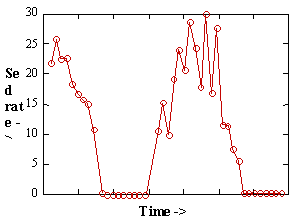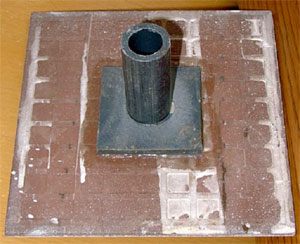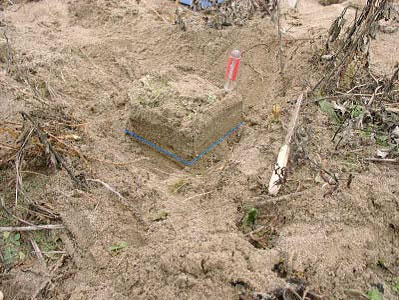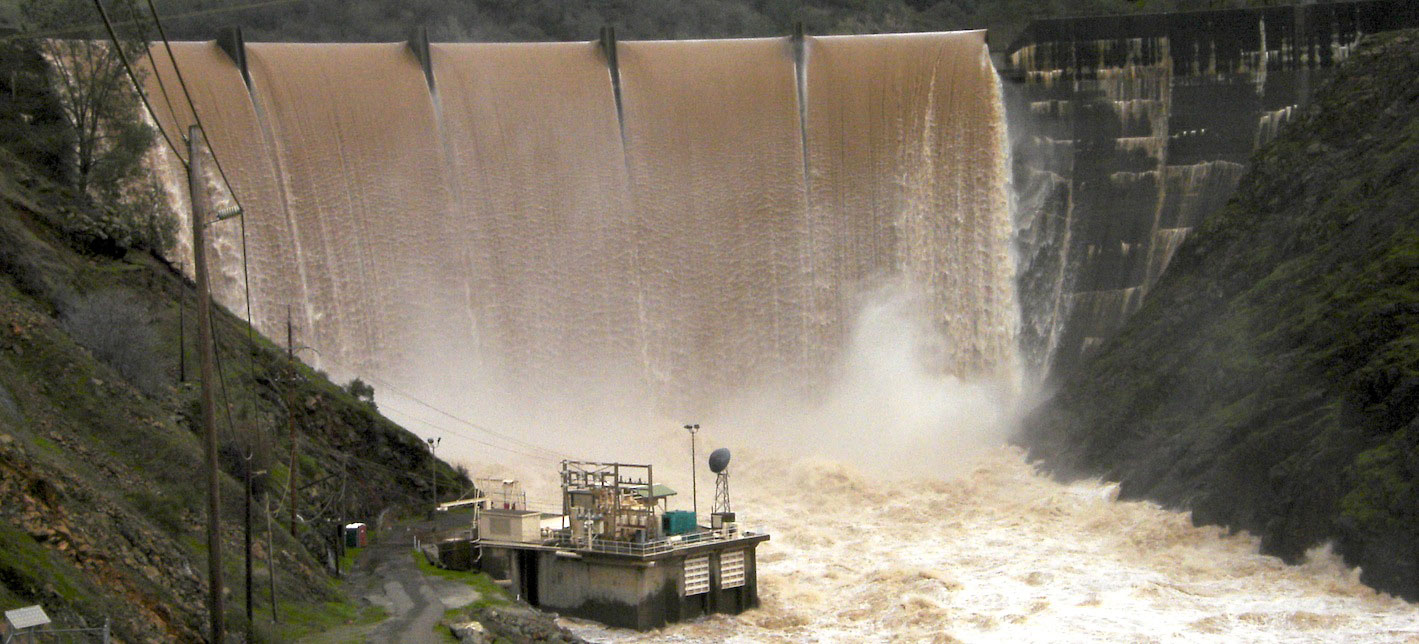Net Sedimentation Tile (NST) Protocol
Net Sedimentation Tile (NST) Protocol For Monitoring Short-term Sediment Fluxes In Depositional Environments
 By Greg Pasternack
By Greg Pasternack
University of California, Davis
gpast@ucdavis.edu
530-754-9243
(As reported in Pasternack and Brush (1998), Pasternack et al. (2000), and Knight and Pasternack (2000))
Background
Several methods for monitoring sedimentation have been developed for a variety of depositional settings (e.g. Serodes and Troude 1984; Reed 1989; Hupp and Bazemore 1993). Marker horizons, filter paper, stage rods, tree burial dendrochronology, sediment erosion tables, and infra-red back-scatter detectors are specific examples of sediment monitoring technologies.
For floodplain and delta settings a method capable of handling spatially and temporally variable deposition rates is needed. Also, it is desirable to have an approach that yields samples for sedimentological and chemical time series analysis. To obtain these data lightweight aluminum pipes are sunk into the ground and capped with a detachable ceramic tile flush with the marsh surface. The detachment mechanism involves gluing a plastic tube to the bottom of each tile. The ceramic tile/acrylic tube assembly drops over the anchor rod and is not susceptible to motion unless subjected to extreme lift forces.
Purpose
To monitor net sediment deposition through time and relate it to hydrologic and geomrophic variables.
Materials
Sediment Tile components:
- 8" x 8" square glazed-ceramic tile (kitchen tiles are suitable)
- 3" long hard plastic pipe with an inner diameter of 3/4"
- 3" x 3" hard plastic squares
- Silicone glue and plastic cement
- 3 1/3' long x 3/4" dia. aluminum tubing. Also known as "EMT conduit".
Referred to here as the "anchor"
Installation aids:
- GPS, 5' x 1" hand auger
- hammer
- 5' x 3/4" aluminum tube
- metal file
- (long) regular screw driver
- pocket knife
- duct tape
- meter stick
- compass
- bright flagging
- hand shovel
- ruler (mm)
- work gloves
Sample collection equipment:
- Pre-washed, pre-weighed, pre-labelled straight glass jars with metal lids
- Large taping knife
- Pocket knife
Installation Procedure
"Tile assembly" preparation:
Using plastic cement, bond a 3" plastic pipe to the center of a plastic square.
Using the silicone glue, bond the other side of the plastic square to the bottom of the ceramic tile

(Oblique view of the underside of an NST)

Field Installation
- Use the GPS to locate the pre-selected tile site as exactly as possible
- Use the hand auger to dig a 3'-deep hole at the site.
- Try as best as possible to preserve auger cuttings in a pile near the hole
- Put the 5' x 3/4" alum. tube into the hole. Hammer it down 4" and pull it out
- This small hole will give the anchor tube a tight fit at the bottom
- Use the screw driver to dig the sediment out of the 5' tube before next use.
- Put the 3.33' by 3/4" anchor down the auger hole and into the small hole at the bottom.
- Before you put it down, make sure that the tile assembly fit easily over the end of the anchor that will be sticking up.
- Sometimes you may be unable to locate the small hole and will have to redo it.
- The top of the anchor should be slightly lower than the ground surface. You may stomp on it if it is too high, but DO NOT hammer it, or the top will dent and the tile won't ft on it. If this happens you may be able to file down the sides of the anchor with the metal file.
- Use the hand shovel to backfill the auger hole with as much of the auger cuttings or nearby surface sediment as possible.
- Try not to leave any cuttings on the ground near the hole, or it may move onto the tile when the water floods the site.
- Use the pocket knife to trim down any vegetation within 8x8" of the anchor.
- Lay the meter stick on the ground with one end on the anchor and the other pointing due east.
- Hammer a second anchor ~1.5' down into the ground at the east end of the meter stick.
- Tie a long strip of flagging to the top of the marker anchor and duct tape it on for security.
- Place tile assembly over sunk anchor.
- If erosion is going to be monitored, it is necessary to record the height of each side of the tile above the marsh surface and the depth of the anchor using a ruler in millimeters. Ideally this should be zero, but with the existing microtopography there will be some variation from the idea case in some settings.
Tile Sample collection
Sediment sampling stations using the above apparatus should be visited on a recurrence interval appropriate for the type of system under study. Too little or too much sediment necessitates extra care in sampling. Recommended sampling intervals are
| System type | Sampling Interval |
| Tidal freshwater wetland | 2-4 weeks |
| Salt marsh | 4-8 weeks |
| Floodplain | Varies with flood regime |
Accumulated sediments need to be collected into a glass jar (or a large bucket in some instances on floodplains). Any vegetation lying across the tile should first be clipped at the edge of the tile and put in the jar by hand. Then, one person holds the jar while the other person uses the taping knife and pocket knife in conjunction to carefully scrape the sediment into the jar. When water content of sediment is not important, distilled water may be used to wash the tile completely clean of sediment. This is only significant when total accumulation is very low, otherwise the error is very small.
Assuming the tile was flat on the ground upon installation, erosion is recorded by measuring the height of each tile side and the anchor rod above the marsh surface and averaging the measurements. If the tile was not flat, measurements need to be adjusted for the known deviation recorded when the tile was installed. Eventually, the erosion depth will be multiplied by sediment bulk density to achieve a mass estimate of erosion. Once erosion is recorded at a site, the tile heights must be tracked from that point forward in time to account for the history of the erosion.
Where both erosion and deposition are evident, the two methods may be combined to obtain net sediment accumulation.
Example of Floodplain sediment deposition over a 1 year period
(blue line indicates location of sediment tile)

Safety Issues
No unique safety issues arise in this procedure. Some typical field hazards you might run into are poison oak/ivy, hitting your hand with a hammer, heat exhaustion, and back pain. Standard field precautions are warranted.
References
Pasternack, G. B. and G. S. Brush. 1998. Sedimentation cycles in a river-mouth tidal freshwater marsh. Estuaries 21:3:407-415.
Pasternack, G. B., W. B. Hilgartner, and G. S. Brush. 2000. Biogeomorphology of an upper Chesapeake Bay river-mouth tidal freshwater marsh. Wetlands 20:3:520-537.
Knight, M. A. and Pasternack, G. B. 2000. Sources, input pathways, and distributions of Fe, Cu, and Zn in a Chesapeake Bay tidal freshwater marsh. Environmental Geology 39:12:1359-1371.


